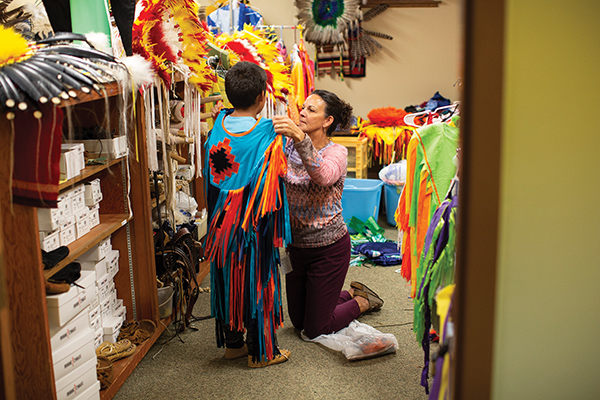(Family Features) Days spent in the classroom are often centered around language, reading, math, science and other traditional curriculum, but there’s another key subject students may learn about without even realizing it: themselves. While coming to understand one’s family background and culture may seem like a daunting task for school-aged children, it can actually be a simple (and fun) opportunity for discovery.
LaRayne Woster is the Native American Studies Lead and Cultural Specialist at St. Joseph’s Indian School, a small nonprofit Native American school making a difference in preserving the culture and heritage of its students. As a cultural specialist, Woster developed a unique project with her students, helping them discover who they are and where they came from.
By developing fun and informative activities like learning their creation story; learning traditional arts, crafts and dances; making a traditional meal; and understanding religious traditions, she challenged her students to connect with their ancestry.
While this activity focused on Native American children, Woster recommends parents and teachers use this exercise and share ideas to help any child connect with his or her own heritage, from Hispanic and African cultures to French, Irish and beyond. Schools like St. Joseph’s provide an environment ideal for students to make those connections as the school is dedicated to improving the quality of life for children and families with a mission to educate mind, body, heart and spirit.
Consider these ways you can promote cultural connections.
 Bond with Someone Who Knows the Culture. One of the easiest ways students can introduce themselves to their own history is by talking with relatives, friends or neighbors who can share wisdom and knowledge. These mentors can provide direction and educational opportunities while taking part in games, dances, storytelling and other cultural traditions.
Bond with Someone Who Knows the Culture. One of the easiest ways students can introduce themselves to their own history is by talking with relatives, friends or neighbors who can share wisdom and knowledge. These mentors can provide direction and educational opportunities while taking part in games, dances, storytelling and other cultural traditions.- Learn a Traditional Game and Share It. Throughout history, people of all cultures played games and took part in activities to spark creative freedom and break free from everyday stressors. Learning and participating in one of these games offers children a fun, hands-on way to connect with their heritage.
- Cook Traditional Foods. While family reunions and holidays are often filled with your loved ones’ favorite meals, the foods of your ancestors may differ dramatically from today’s classics. Connecting with the past can be as easy as researching recipes, heading to the store for a few ingredients and spending cherished moments together in the kitchen.
- Do a Traditional Dance. Folk dances from around the world have been passed down from generation to generation. Native American grass dances, Lakota dances and rain dances are popular examples that offer lively, entertaining ways to connect with the past.
- Study Oral Traditions and Learn to Tell the Stories. Whether your culture dates back hundreds of years or thousands, there are tales to be told. Learn some of your ancestors’ most influential stories from creation and ancient history to modern folktales and retell them to friends and family.
- Read the Works of Early Authors. Studying your culture’s most well-known authors, fiction or non-fiction, can give you a glimpse into the past. Even fictional works provide a gateway to the thinking, traditions, beliefs and more of those who came before you.
- Learn the Traditional Language. For students whose ancestors spoke a different language or communicated in a different manner than people today, studying that language provides a direct connection to the culture. In fact, learning the language can be an exciting experience to communicate with an elder in your community who speaks fluently.
- Come to Know and Respect Your Family. While history and its traditions may seem long, long ago, your closest possible connections to that past are the loved ones you see every day. Bonding over your newfound knowledge of your shared heritage is a profound opportunity to grow closer, connect with your background and celebrate those who came before you.
Visit stjo.org to find more fun, student-friendly ways to discover and preserve the past.
Photo courtesy of Getty Images (family cooking)
Photo courtesy of St. Joseph’s Indian School (woman dressing child in traditional feathers)
Source:







